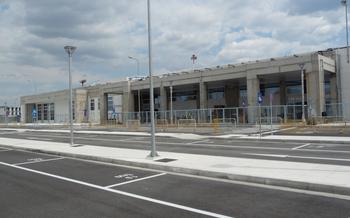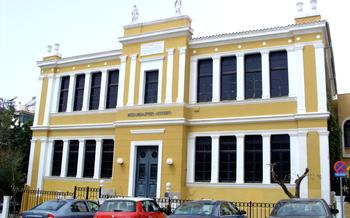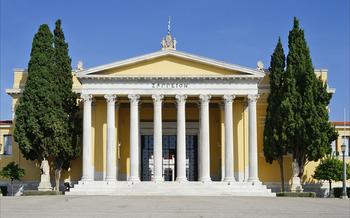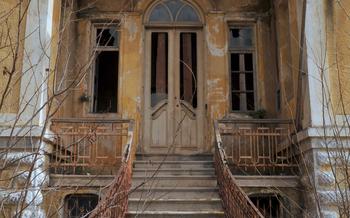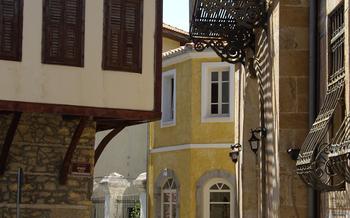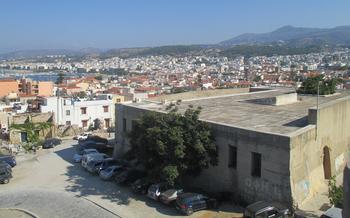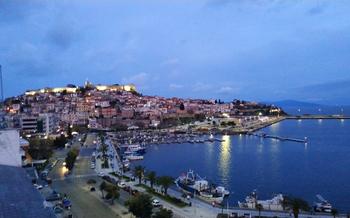
Folklore Museum of Feres
- The Folklore Museum of Feres: A Journey Through History and Tradition
- Location and Accessibility
- Exploring the Museum's Exhibits
- Feres Through the Ages
- Interactive Exhibits and Workshops
- The Museum's Role in Preserving Cultural Heritage
- Events and Festivals
- Local Cuisine and Dining Options
- Nearby Attractions
- A Walk Through the Town of Feres
- Photography Opportunities
- The Museum as a Community Hub
- Sustainable Tourism Practices
- Insider Tip: Hidden Gems of the Museum
The Folklore Museum of Feres: A Journey Through History and Tradition
Nestled in the heart of the picturesque town of Feres, the Folklore Museum of Feres stands as a testament to the rich cultural heritage of the region. This remarkable institution offers visitors a unique opportunity to delve into the past and explore the traditions that have shaped the identity of this vibrant town.
Established in 1973, the museum is housed in a charming traditional building that exudes an aura of authenticity. Its collection boasts over 2,000 artifacts, meticulously curated to showcase the diverse aspects of local life and customs. From intricate textiles and traditional costumes to household items, agricultural tools, and handcrafted crafts, each exhibit tells a captivating story of the people who have inhabited this land for centuries.
As you wander through the museum's galleries, you'll gain a profound appreciation for the ingenuity and creativity of the Feres community. The displays highlight the town's agricultural roots, showcasing the tools and techniques used by farmers to cultivate the fertile land. You'll also discover the vibrant textile traditions, with intricate embroidery and woven fabrics adorning traditional costumes and household linens.
More than just a repository of artifacts, the Folklore Museum of Feres serves as an educational and cultural center, fostering a deep understanding of the region's heritage. Through its exhibits, workshops, and events, the museum plays a vital role in preserving and promoting the unique traditions of Feres, ensuring that they continue to thrive for generations to come.
Location and Accessibility
The Folklore Museum of Feres is conveniently located in the heart of the town, on Eleftheriou Venizelou Street, just a short walk from the main square. Reaching the museum is easy, whether you are traveling by car, public transportation, or on foot. For those arriving by car, there is ample street parking available in the surrounding area. The museum is also well-connected by public transportation, with several bus stops within walking distance. For visitors with disabilities, the museum is fully accessible, with ramps and elevators providing easy access to all exhibits.
Exploring the Museum's Exhibits
The Folklore Museum of Feres takes visitors on a journey through time, showcasing the rich cultural heritage of the region through its diverse exhibits. The museum is divided into several thematic sections, each dedicated to a different aspect of traditional life in Feres. Visitors can admire a collection of traditional costumes and textiles, intricately embroidered and reflecting the local craftsmanship. Household items and tools, such as pottery, utensils, and looms, provide a glimpse into the daily lives of Feres' residents. Agricultural implements and crafts, including farming tools and handmade rugs, showcase the town's agricultural and artisanal traditions. Interactive exhibits and workshops further enhance the museum experience, allowing visitors to engage with the exhibits and learn about the cultural significance of each item.
Feres Through the Ages
The town of Feres boasts a rich and storied history, with roots that stretch back to ancient times. Its origins can be traced to the 5th century BC, when it was known as "Pherae" and served as a significant city-state in the region of Thrace. During the Hellenistic period, Feres flourished as a center of trade and culture, leaving behind impressive archaeological remains that can still be admired today.
In the 14th century, Feres fell under Ottoman rule and became a vibrant hub of commerce and craftsmanship. The town's strategic location along trade routes facilitated the exchange of goods and ideas, leading to a unique blend of cultural influences. This period witnessed the construction of mosques, bathhouses, and other architectural landmarks that remain integral to Feres' identity.
After gaining independence from the Ottomans in 1922, Feres underwent a period of transformation. Many refugees from Asia Minor settled in the town, bringing with them their own traditions and customs. This influx of newcomers further enriched the town's cultural tapestry, shaping its modern-day character. Today, Feres stands as a testament to its diverse heritage, seamlessly blending ancient, Ottoman, and modern elements that captivate visitors from around the world.
Interactive Exhibits and Workshops
The museum offers interactive exhibits and workshops that provide visitors with a hands-on experience of traditional crafts and customs. Skilled artisans demonstrate their techniques, allowing visitors to learn about the processes behind pottery, weaving, embroidery, and other traditional arts. Visitors can also participate in cooking classes, learning to prepare delicious Greek dishes using local ingredients and traditional methods. There are educational programs designed specifically for children, encouraging them to explore Greek culture and heritage through interactive activities and storytelling. These workshops and activities bring the museum's exhibits to life, creating a dynamic and engaging experience for visitors of all ages.
The Museum's Role in Preserving Cultural Heritage
The Folklore Museum of Feres plays a vital role in preserving and promoting the rich cultural heritage of the region. It serves as a repository for traditional artifacts, customs, and practices that would otherwise be lost to time. The museum's collection is meticulously documented and cataloged, ensuring that future generations can learn about and appreciate the diverse cultural expressions of the area.
The museum also collaborates closely with local artisans, historians, and community members to document and safeguard intangible aspects of cultural heritage, such as traditional crafts, music, and storytelling. Through educational outreach programs and workshops, the museum actively engages with the community to raise awareness about the importance of preserving cultural traditions and passing them on to future generations.
By preserving and promoting local cultural heritage, the Folklore Museum of Feres contributes to the cultural identity and vitality of the region. It serves as a reminder of the rich history and traditions that have shaped the community and ensures that these traditions continue to be celebrated and appreciated for years to come.
Events and Festivals
The Folklore Museum of Feres is not just a static repository of artifacts; it is a vibrant hub for cultural events and festivals that bring the town's traditions to life. Throughout the year, the museum hosts a variety of events that showcase local music, dance, cuisine, and crafts.
One of the most popular events is the annual Feres Folklore Festival, held every summer. This lively festival features traditional music and dance performances, cooking demonstrations, craft workshops, and a bustling bazaar showcasing local products. Visitors can immerse themselves in the rich cultural heritage of the region, learn about traditional arts and crafts, and savor the delicious flavors of Feres' cuisine.
Other events held at the museum include seasonal workshops on traditional crafts such as weaving, embroidery, and pottery, as well as cooking classes where visitors can learn to prepare authentic Greek dishes using local ingredients. These interactive experiences provide a unique opportunity to engage with local artisans and learn about their skills firsthand.
The Folklore Museum of Feres is committed to preserving and promoting the cultural heritage of the region, and its events and festivals play a vital role in achieving this mission. By showcasing local traditions and providing opportunities for cultural immersion, the museum fosters a sense of pride and connection among the community members and visitors alike.
Local Cuisine and Dining Options
When exploring Feres, immersing yourself in the local culinary scene is a must. The town offers a delightful array of traditional dishes that reflect the region's rich history and cultural influences. From savory pies and grilled meats to fresh seafood and homemade pastries, there's something to satisfy every palate.
For an authentic dining experience, head to one of the traditional tavernas in Feres. These cozy establishments serve up mouthwatering dishes prepared with local ingredients and traditional recipes. Indulge in dishes like "giouvetsi" (beef or lamb stew with orzo pasta), "saganaki" (fried cheese), and "loukaniko" (spicy sausage).
Budget-conscious travelers can find affordable options at the local street food stalls, offering delicious snacks and quick bites. Try the "souvlaki" (grilled meat skewers) or "gyros" (pita bread filled with meat, tomatoes, onions, and tzatziki sauce).
If you're passionate about cooking, consider taking a cooking class or food tour to learn more about the local cuisine. These experiences provide hands-on opportunities to learn traditional recipes and techniques from local chefs. You'll not only enjoy a delicious meal but also gain a deeper understanding of the region's culinary heritage.
Nearby Attractions
Beyond the Folklore Museum, the town of Feres and its surrounding area offer a wealth of attractions for visitors to explore. History buffs will find the Archaeological Museum of Feres, showcasing artifacts from the region's ancient past, a must-visit. Nature enthusiasts can revel in the beauty of the nearby Nestos Delta National Park, a haven for birdwatching and outdoor activities. For those seeking adventure, the Evros River, which forms the border between Greece and Turkey, beckons with opportunities for kayaking, fishing, and river safaris. Day trips to neighboring towns and villages, such as Soufli, Didymoteicho, and Orestiada, offer a chance to delve deeper into the region's rich cultural heritage and traditions.
A Walk Through the Town of Feres
After immersing yourself in the rich history and traditions of the region at the Folklore Museum of Feres, take some time to explore the charming town itself. Stroll through the narrow, winding streets and alleys, lined with traditional whitewashed houses and colorful shops. Admire the intricate architecture, with its ornate balconies and decorative details, which reflects the town's rich cultural heritage.
Feres is known for its friendly and welcoming atmosphere, so don't hesitate to interact with the locals. They will be more than happy to share stories about their town and its history, or perhaps even recommend some hidden gems that only they know about.
As you wander through Feres, keep an eye out for local shops and boutiques selling unique souvenirs, handmade crafts, and delicious local products. You'll find everything from traditional textiles and pottery to aromatic spices and freshly baked pastries.
Be sure to visit the town's main square, where you can relax in a café, soak up the vibrant atmosphere, and watch the world go by. The square is often used for local events and gatherings, so you might be lucky enough to catch a traditional dance performance, a music festival, or a lively market.
Photography Opportunities
The Folklore Museum of Feres offers ample opportunities for capturing stunning photographs that encapsulate the essence of Greek history, tradition, and culture. Within the museum's walls, visitors can find numerous Instagram-worthy spots that showcase the intricate details of traditional costumes, household items, and agricultural implements. The vibrant colors and textures of the exhibits provide a feast for the eyes, making photography an ideal way to preserve the memories of your visit.
In addition to the indoor exhibits, Feres itself is a picturesque town that offers a wealth of photographic opportunities. The charming streets and alleys, lined with traditional houses and shops, provide a glimpse into the town's rich past. Hidden gems, such as quaint courtyards and colorful murals, await discovery around every corner.
For the best photography experience, be sure to bring your camera or smartphone and take advantage of the natural light that streams through the museum's windows. Experiment with different angles and perspectives to capture the unique beauty of each exhibit. And don't forget to share your stunning photos on social media, using hashtags like #FolkloreMuseumOfFeres, #FeresGreece, and #GreekTraditions to connect with fellow travelers and photography enthusiasts.
The Museum as a Community Hub
The Folklore Museum of Feres is not just a repository of cultural artifacts; it is also a vibrant community hub that fosters cultural exchange, dialogue, and a sense of belonging among the locals. The museum regularly hosts events and gatherings that bring people together to celebrate their shared heritage and traditions. These events often feature traditional music, dance, storytelling, and culinary demonstrations, providing an immersive experience for visitors.
In addition, the museum supports local artists and entrepreneurs by showcasing their work and organizing workshops and exhibitions. This not only helps to promote local talent but also strengthens the cultural fabric of the community. The museum's commitment to community engagement extends beyond its walls as it collaborates with local schools and organizations to develop educational programs and initiatives that instill a sense of pride in the younger generation.
Sustainable Tourism Practices
The Folklore Museum of Feres is committed to promoting sustainable tourism practices and preserving the region's natural and cultural heritage for future generations. The museum has implemented several green initiatives, including using energy-efficient lighting and heating systems, recycling and composting waste, and reducing water consumption. The museum also encourages visitors to adopt responsible tourism behavior, such as using public transportation or walking instead of driving, respecting local customs and traditions, and supporting local businesses. By showcasing sustainable practices and raising awareness among visitors, the museum contributes to the preservation of Feres' unique cultural heritage while ensuring its long-term sustainability.
Insider Tip: Hidden Gems of the Museum
Beyond the main exhibits, the Folklore Museum of Feres holds hidden gems that are waiting to be discovered by curious visitors. One such treasure is the secret room, tucked away in a secluded corner of the museum. This hidden chamber houses a collection of rare and unique artifacts, including ancient manuscripts, intricate jewelry, and traditional musical instruments. Access to the secret room is limited, and visitors are advised to inquire with the museum staff to arrange a special viewing.
Another hidden gem of the museum is its collection of traditional costumes and textiles. These exquisite garments, meticulously crafted by local artisans, showcase the rich cultural heritage of the region. Visitors can admire the vibrant colors, intricate embroidery, and unique designs that reflect the diverse ethnicities and traditions of Feres.
To make the most of your visit, be sure to participate in the museum's interactive workshops and demonstrations. These hands-on experiences offer a deeper understanding of traditional crafts, such as pottery, weaving, and woodworking. Visitors can learn from skilled artisans, try their hand at creating their own crafts, and take home a unique souvenir to cherish.
With its hidden gems, special exhibitions, and engaging activities, the Folklore Museum of Feres offers an unforgettable experience for visitors who seek to delve into the heart of Greek culture and heritage.
